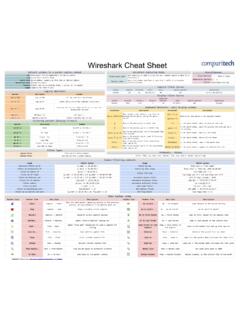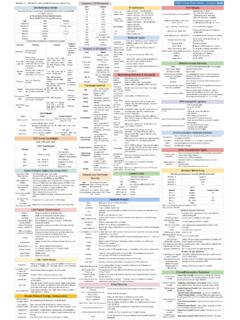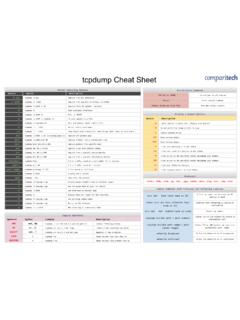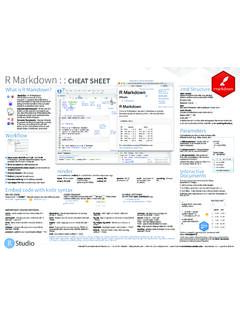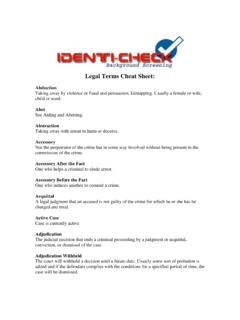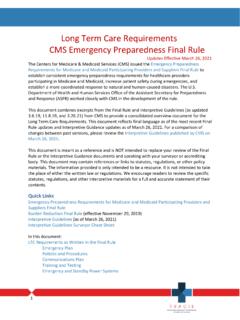Transcription of CISSP Cheat Sheet Series Security Models System Evaluation ...
1 CISSP Cheat Sheet SeriesSecurity Models and ConceptsSecurity architecture frameworksZachman FrameworkA 2D model considering interrogations such as what, where and when with, etc. With various views such as planner, owner, designer Applied Business Security Architecture (SABSA)To facilitate communication between stakeholdersInformation Technology Infrastructure Library (ITIL)Set of best practices for IT service managementSecurity architecture documentationISO/IEC 27000 SeriesEstablish Security controls published by Standardization (ISO) and the Electrotechnical Commission (IEC)Control Objectives for Information and Related Technology (CobiT)Define goals and requirements for Security controls and the mapping of IT Security controls to business of Security modelsState Machine ModelsCheck each of the possible System state and ensure the proper Security relationship between objects and subjects in each Lattice ModelsAllocate each Security subject a Security label defining the highest and lowest boundaries of the subject s access to the System .
2 Enforce controls to all objects by dividing them into levels known as Based ModelsArrange tables known as matrix which includes subjects and objects defining what actions subjects can take upon another ModelsConsider the state of the System at a point in time for a subject, it consider preventing the actions that take place at one level which can alter the state of another Flow ModelsTry to avoid the flow of information from one entity to another which can violate the Security and Write are allowed or restricted using a specific memory location, in UseScoping & tailoringSecurity ModesDedicated Security ModeUse a single classification level. All objects can access all subjects, but users they must sign an NDA and approved prior to access on need-to-know basisSystem High Security ModeAll users get the same access level but all of them do not get the need-to-know clearance for all the information in the Security ModeIn addition to System high Security level all the users should have need-to-know clearance and an NDA, and formal approval for all access required Security ModeUse two classification levels as System Evaluation and Assurance LevelsSecurity ModelsMATRIX(Access control model)- Provides access rights including discretionary access control to subjects for different Read, write and execute access defined in ACL as matrix columns and rows as capability (Confidentiality model)-A subject cannot read data at a higher Security level.
3 ( simple Security rule)- Subject in a defined Security level cannot write to a lower Security level unless it is a trusted subject. ( *-property (star property) rule- Access matrix specifies discretionary access subject with read and write access should write and read at the same Security level ( Strong star rule :)- Tranquility prevents Security level of subjects change between (Integrity model)- Cannot read data from a lower integrity level ( The simple integrity axiom)- Cannot write data to an object at a higher integrity level. ( the * (star) integrity axiom)- Cannot invoke service at higher integrity. ( The invocation property)- Consider preventing information flow from a low Security level to a high Security WILSON(Integrity model)User: An active agent Transformation Procedure (TP): An abstract operation, such as read, writes, and modify, implemented throughProgramming Constrained Data Item (CDI): An item that can be manipulated only through a TP Unconstrained Data Item (UDI): An item that can be manipulated by a user via read and write operations- Enforces separation of duty- Requires auditing- Commercial use- Data item whose integrity need to be preserved should be audited- An integrity verification procedure (IVP) -scans data items and confirms their integrity against external threatsInformation flow modelInformation is restricted to flow in the directions that are permitted by the Security policy.)
4 Thus flow of information from one Security level to another. (Bell & Biba).Brewer and Nash( Chinese wall model)- Use a dynamic access control based on objects previous Subject can write to an object if, and only if, the subject cannot read another object in a different Prevents conflict of interests among ModelCommercial mode (Confidentiality and Integrity,) -BLP + BibaGraham-Denning ModelObjects, subjects and 8 rulesRule 1: Transfer Access, Rule 2: Grant Access, Rule 3: Delete Access, Rule 4: Read Object, Rule 5: Create Object, Rule 6: destroy Object, Rule 7: Create Subject, Rule 8: DestroyHarrison-Ruzzo-Ullman ModelRestricts operations able to perform on an object to a defined set to preserve Evaluation and Assurance LevelsTrusted Computer System Evaluation Criteria(TCSEC)Evaluates operating systems, application and systems. But not network part. Consider only about confidentiality. Operational assurance requirements for TCSEC are: System Architecture, System Integrity, Covert Channel analysis, Trusted Facility Management and Trusted BookA collection of criteria based on the Bell-LaPadula model used to grade or rate the Security offered by a computer System BookSimilar to the Orange Book but addresses network BookPassword Computer System Evaluation Criteria(TCSEC)Evaluates operating systems, application and systems.
5 But not network part. Consider only about confidentiality. Operational assurance requirements for TCSEC are: System Architecture, System Integrity, Covert Channel analysis, Trusted Facility Management and Trusted all 3 CIA (integrity and availability as well as confidentialityTCSECE xplanationDMinimal protectionC1 DAC; Discretionary Protection (identification, authentication, resource protection)C2 DAC; Controlled access protectionB1 MAC; Labeled Security (process isolation, devices)B2 MAC; Structured protectionB3 MAC; Security domainAMAC; verified protectionCommon criteria assurance levelsEAL0 Inadequate assuranceEAL1 Functionality testedEAL2 Structurally testedEAL3 Methodically tested and checkedEAL4 Methodically designed, tested and reviewedEAL5 Semi-formally designed and testedEAL6 Semi-formally verified, designed and testedEAL7 Formally verified, designed and testedITSEC Security Evaluation criteria - required levelsD + E0 Minimum ProtectionC1 + E1 Discretionary Protection (DAC)C2 + E2 Controlled Access Protection (Media cleansing for reusability)B1 + E3 Labelled Security (Labelling of data)B2 + E4 Structured Domain (Addresses Covert channel)B3 + E5 Security Domain (Isolation)A + E6 Verified Protection (B3 + Dev Cycle))
6 Common criteria protection profile componentsDescriptive Elements Rationale Functional Requirements Development assurance requirements Evaluation assurance requirementsCertification & AccreditationCertificationEvaluation of Security and technical/non-technical features to ensure if it meets specified requirements to achieve that an IT System is approved to operate in predefined conditions defined as a set of safety measures at given risk Accreditation ProcessPhase 1: Definition Phase 2: Verification Phase 3: Validation Phase 4: Post AccreditationAccreditation TypesType AccreditationEvaluates a System distributed in different AccreditationEvaluates an application AccreditationEvaluates the System at a specific operating systems run on virtual machines and hypervisors run on one or more host physical Security threatsTrojan infected VMs, misconfigured hypervisorCloud computing modelsSoftware as A Service (SaaS), Infrastructure As A Service (IaaS), Platform As A Service (PaaS)
7 Cloud computing threatsAccount hijack, malware infections, data breach, loss of data and integrityMemory ProtectionRegisterDirectly access inbuilt CPU memory to access CPU and Memory Segment Used by processors for Operating System ArchitectureAll of the code working in kernel Addressing Identification of memory locations by the Addressing CPU access registry to get Addressing Part of an instruction during information supply to AddressingActual address of the memory location is used by Addressing Same as direct addressing but not the actual memory + Offset Addressing Value stored in registry is used as based value by the CPU.*Citation CISSP SUMMARY BY Maarten De FrankrijkerWeb SecurityOWASPOpen-source application Security project. OWASP creates guidelines, testing procedures, and tools to use with web Top 10 Injection / SQL Injection, Broken Authentication, Sensitive Data Exposure, XML External Entity, Broken Access Control, Security Misconfiguration, Cross-Site Scripting (XSS), Insecure Deserialization, Using Components with Known Vulnerabilities, Insufficient Logging and MonitoringSQL Injections:Attackers try to exploit by allowing user input to modify the back-end/server of the web application or execute harmful code which includes special characters inside SQL codes results in deleting database tables Injection prevention: Validate the inputs and Scripting (XSS)Attacks carryout by inputting invalidated scripts inside ForgeryAttackers use POST/GET requests of the http web pages with HTML forms to carry out malicious activity with user accounts.
8 Prevention can be done by authorization user accounts to carry the actions. Eg. using a Random string in the form, and store it on the Goals( ) P - Privacy (Confidentiality) A Authentication I - Integrity N - Non-Repudiation. Key space = 2n. (n is number of key bits)Use of Cryptography Confidentiality Integrity Proof of origin Non-repudiation Protect data at rest Protect data in transitCryptographic TerminologyEncryptionConvert data from plaintext to cipher from ciphertext to value used in encryption conversion or decryption happens or decryption requests done subsequently or after a waiting private key use for encryption and pair use for encrypting and decrypting. (One private and one public key)Digital SignatureUse to verify authentication and message integrity of the sender. The message use as an input to a hash functions for validating user one-way function, convert message to a hash value used to verify message integrity by comparing sender and receiver CertificateAn electronic document that authenticate certification text text converted to special format where it is unreadable without reconversion using set of components used for encryption.
9 Includes algorithm, key and key management decrypting ciphertext without knowledge of cryptosystem AlgorithmProcedure of enciphers plaintext and deciphers cipher science of hiding the communication messages from unauthorized + CryptanalysisDecipherConvert the message as the message as unreadable or pad (OTP)Encipher all of the characters with separate unique ClusteringDifferent encryption keys generate the same plaintext SpaceEvery possible key value for a specific mathematical function used in encryption and decryption of data; science of the plaintext to hide the original message; or repeating characters (1 byte) in a message with another of a random set of non-repeating characters. One time a key value during each circle of the the location of the plaintext inside the cipher EffectWhen any change in the key or plaintext significantly change the KnowledgeSegregation of Duties and Dual factorThe time and resources needed to break the number to provide randomness to cryptographic CipherDividing plaintext into blocks and assign similar encryption algorithm and CipherEncrypt bit wise - one bit at a time with corresponding digit of the DivingUnauthorized access a trash to find confidential spoofed messages as originate from a trusted EngineeringMislead a person to provide confidential kiddieA moderate level hacker that uses readily found code from the vs.
10 CiphersClassical CiphersSubstitution cipher, Transposition cipher, Caesar Cipher, CiphersBlock cipher, Stream cipher, Steganography, CipherCipher converts Plaintext to another written text to hide original CiphersUses a key to substitute letters or blocks of letters with different letters or block of letters. One-time pad, CiphersReorder or scramble the letters of the original message where the key used to decide the positions to which the letters are vs. Asymmetric EncryptionSymmetric AlgorithmsUse a private key which is a secret key between two parties. Each party needs a unique and separate private of keys = x(x-1)/2 where x is the number of users. Eg. DES, AES, IDEA, Skipjack, Blowfish, Twofish, RC4/5/6, and Based Symmetric CipherEncryption done bitwise and use keystream generators Eg. Symmetric CipherEncryption done by dividing the message into fixed-length blocks Eg. IDEA, Blowfish and, RC5 AlgorithmsUse public and private key where both parties know the public and the private key known by the owner.


